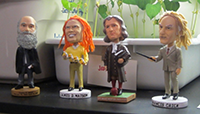Statement on Collaboration and Community
As defined in the RCOE Conceptual Framework, a Community of Practice (CoP) is “a web of individuals bound together by a common set of goals and values.” The group of individuals nominated for this award include the four science educators from the Department of Curriculum and Instruction: Leslie Bradbury, Jeff Goodman, Lisa Gross, and Rachel Wilson. We are connected through the common course that we teach, CI 4401: Science and Science Teaching in the Elementary School.
As a community of science educators, we are a part of many groups which extend beyond our team of four. We learn from each other, as well as from the other CoPs of which we are a part. We are members of CoPs that function on multiple levels, including our students (present and past), our public school teacher partners, and the larger science education community. Additionally, we work closely with our departmental, college, and university colleagues. Our portfolio of supporting documents will demonstrate that we are active participants in each of these communities, and the amount of time and effort that we spend working with these various groups indicates how much we value these connections.
As science educators, we are committed to functioning as a core CoP with a shared philosophy which is anchored solidly by a foundation of social constructivist principles. Specifically, we believe that people learn best when they are able to construct knowledge through direct experiences with the phenomena that they are studying. Frequently, this learning occurs in group settings (Phillips, 2000). We apply our shared philosophy to all aspects of our work including scholarship, teaching, and service.
Documentation supporting our shared scholarship will indicate that we function as a CoP through our collaboration on research projects that result in presentations to practitioners as well as researchers. These projects have been occurring for many years, and as we have added new science faculty members, they have become integral to our science education CoP. Our most recent endeavor focused on the use of iPads to teach concepts related to forces and motion to our pre-service elementary students.
In the section of our portfolio which addresses our teaching, we will discuss how our shared philosophy has led us to develop several common course assignments which provide meaningful experiences for our students. In constructing our course, we think carefully about how to model the type of science teaching that we want our students to enact in their own classrooms. Not reflected in our formal statements and artifacts are the number of informal interactions that occur on a nearly daily basis. These communications include emails about cool science news we have just heard, or links to stories or videos that we may want to share with our students. Additionally, we regularly engage in “hallway conversations” where we reflect on activities that are working well in our classes, or science topics where we are struggling to find effective pedagogical approaches.
As a group, we are particularly proud of our service, especially to the public schools. We feel strongly that we benefit as science educators when we have the opportunity to work with our public school partners. Our supporting evidence will present the multiple ways that we interact with teachers, elementary children, and our own pre-service teachers in field-based settings. We regularly develop and implement science lessons in public school classrooms. Our most recent project involves writing a grant to obtain books and science materials for a school in Wilkes County. We will work with the teachers to implement inquiry-based science lessons using the materials.
Clearly, it is difficult in many cases to make clear distinctions between the areas of teaching, scholarship, and service as there is great overlap between the three. For example, our service and experience with public school students and their teachers informs our teaching approaches and assignments in the science methods class. These opportunities in the public schools lead to chances to publish and present the results of our experiences. As we develop questions about effective approaches to teaching elementary science methods, new avenues are opened for research. It is the intersection between each of these areas that informs each of the CoPs of which we are a part.
On a less academic but equally important note, our close personal bonds contribute greatly to our functioning as a CoP. The image found on the front page of our portfolio is a photograph of the four Bobble Heads that reside on Leslie Bradbury’s desk. There is one Bobble Head to represent each of the four science educators. In the beginning, we only had the two that she had initially received as a birthday present from Jeff and Lisa to represent themselves. However, it bothered Jeff so much that we did not have everyone represented that he got two more and decorated them to represent Leslie and Rachel. This story is emblematic of the feelings that we have for each other. We are friends in addition to being colleagues which allows us a level of honesty and trust in our work together. We know each other’s strengths and limitations which allows us to work together in a way that the outputs that we produce together are better than what any of us would have accomplished separately. When we have differences of opinion or tensions arise, we are able to work through them in a productive way to come to a new common ground that is better than where we were before. Each of us is pushed in new directions, which allows us to move forward as a group. As result, we benefit as individuals as do the members of each of our CoPs.
Phillips, D. (Ed.) (2000). Constructivism in education. Chicago: University of Chicago Press.
.
